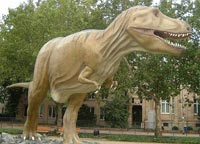

 |
The Dinosaurs (From greek: terrible and lizard/reptile). Dinosaurs were vertebrate animals that dominated the terrestrial ecosystem for over 160 million years, first appearing approximately 230 million years ago. At the end of the Cretaceous period 65 million years ago, dinosaurs suffered a catastrophic extinction, which ended their dominance on land. Modern birds are considered to be the direct descendants of theropod dinosaurs. |
THE DINOSAURSSince the first dinosaur was recognized in the 19th century, their mounted, fossilized skeletons have become major attractions at museums around the world. Dinosaurs have become a part of world culture and remain consistently popular, especially among children. They have been featured in best-selling books and blockbuster films such as Jurassic Park, and new discoveries are regularly covered by the media. The term dinosaur is also used informally to describe any prehistoric reptile, such as the pelycosaur Dimetrodon, the winged pterosaurs, and the aquatic ichthyosaurs, plesiosaurs, and mosasaurs, though none of these are actually dinosaurs. Dinosaurs were extremely varied. Some were herbivorous, others carnivorous. Some dinosaurs were bipeds, some were quadrupeds, and others (such as the dinosaur Ammosaurus) could walk easily on two or four legs. Under phylogenetic taxonomy, dinosaurs are defined as all descendants of the most recent common ancestor of Triceratops and modern birds. Ornithischia is defined as all taxa sharing a more recent common ancestor with Triceratops than with Saurischia. Saurischia is defined as all taxa sharing a more recent common ancestor with birds than with Ornithischia. It has also been suggested that Dinosauria be defined as all the descendants of the most recent common ancestor of Megalosaurus and Iguanodon. There is an almost universal consensus among paleontologists that birds are the descendants of theropod dinosaurs. Using the strict cladistical definition that all descendants of a single common ancestor are related, modern birds are dinosaurs and dinosaurs are, therefore, not extinct. Modern birds are classified by most paleontologists as belonging to the subgroup Maniraptora, which are coelurosaurs, which are theropods, which are saurischians, which are dinosaurs. However, referring to birds as "avian dinosaurs" and to all other dinosaurs as "non-avian dinosaurs" is clumsy. Birds are still birds, at least in popular usage and among ornithologists. It is also technically correct to refer to birds as a distinct group under the older Linnaean classification system, which accepts paraphyletic taxa that exclude some descendants of a single common ancestor. Paleontologists mostly use cladistics, which classifies birds as dinosaurs, to construct their taxonomies, but many other scientists do not. For clarity, this article will use "dinosaur" as a synonym for "non-avian dinosaur", and "bird" as a synonym for "avian dinosaur" (meaning any animal that evolved from the common ancestor of Archaeopteryx and modern birds). It should be noted that this article's definition of "bird" differs from the definition common in everyday language; to most non-scientists, a "bird" is simply a two-legged animal with wings and feathers. |
|